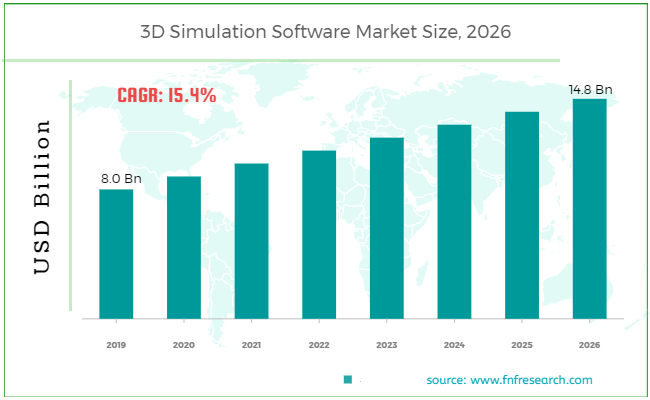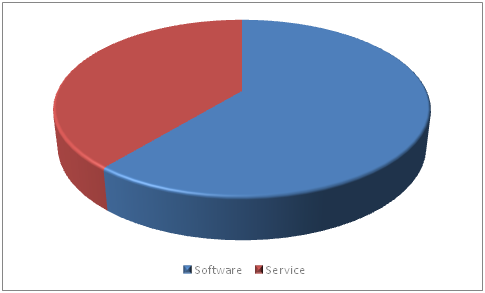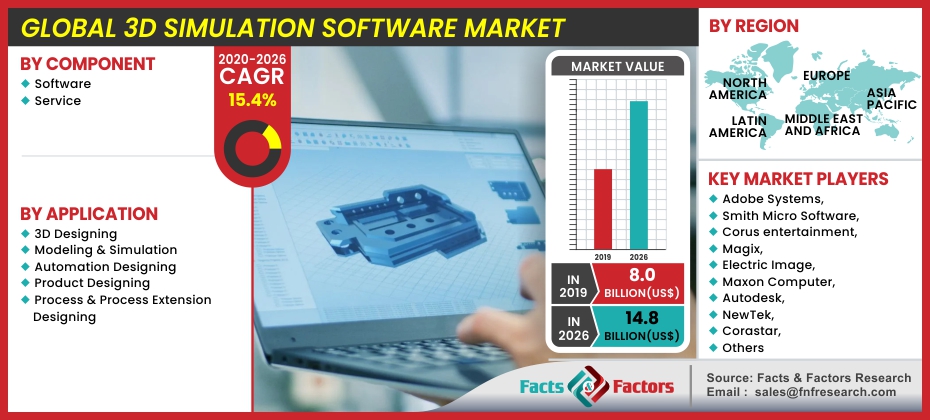Search Market Research Report
3D Simulation Software Market Size, Share Global Analysis Report, 2020–2026

3D Simulation Software Market By Component (Software, and Service), By Application (3D Designing, Modeling & Simulation, Automation Designing, Product Designing, and Process & Process Extension Designing): Global Industry Outlook, Market Size, Business Intelligence, Consumer Preferences, Statistical Surveys, Comprehensive Analysis, Historical Developments, Current Trends, and Forecast 2020–2026
Industry Insights
[190+ Pages Report] According to the report published by Facts Factors, the global 3D simulation software market size was worth around USD 8.0 billion in 2019 and is predicted to grow to around USD 14.8 billion by 2026 with a compound annual growth rate (CAGR) of roughly 15.4% between 2020 and 2026. The report analyzes the global 3D simulation softwaremarket drivers, restraints/challenges, and the effect they have on the demands during the projection period. In addition, the report explores emerging opportunities in the 3D simulation software market.

This specialized and expertise oriented industry research report scrutinizes the technical and commercial business outlook of the 3D simulation software industry. The report analyzes and declares the historical and current trends analysis of the 3D simulation software industry and subsequently recommends the projected trends anticipated to be observed in the 3D simulation software market during the upcoming years.
The 3D simulation software market report analyzes and notifies the industry statistics at the global as well as regional and country levels in order to acquire a thorough perspective of the entire3D simulation software market. The historical and past insights are provided for FY 2016 to FY 2019 whereas projected trends are delivered for FY 2020 to FY 2026. The quantitative and numerical data is represented in terms of value (USD Million) from FY 2016 – 2026.
 Key Insights from Primary Research
Key Insights from Primary Research
- North America has accounted for the highest market size in the 3D simulation software market owing to increased investments in the market in this region
- Asia Pacific is expected to grow with the highest CAGR during the forecast period owing to smart city initiatives taken by the government in this region
- Increased urbanization is supposed to fuel market growth. The companies are supposed to invest in R&D to innovate better products. Innovation will open new opportunities for the 3D Simulation Softwarethus is expected to propel the industry demand in the upcoming years.
- During the forecast era, Europe is expected to be the second-largest market for 3D simulation software due to the high adoption of software design in the automotive sector in Europe.
- The “software” category, on the basis of component segmentation, was the leading category accounting for more than 50.0% share, in 2019.
 Key Recommendations from Analysts
Key Recommendations from Analysts
- There is a huge demand from automotive sectors for 3D simulation software which makes the user produce and design the best product by using its features
- Adoption of 3D simulation software by different companies is increasing its demand
- China's3D simulation software market is anticipated to rise at the highest rate between 2020 and 2026.
- Our analysts have identified the “software” category as the leading investment pockets for the Asia Pacific3D simulation software market in terms of the component.
 Global 3D Simulation Software Market Revenue Share – By Component
Global 3D Simulation Software Market Revenue Share – By Component

The quantitative data is further underlined and reinforced by comprehensive qualitative data which comprises various across-the-board market dynamics. The rationales which directly or indirectly impact the 3D simulation software industry are exemplified through parameters such as growth drivers, restraints, challenges, and opportunities among other impacting factors.
Throughout our research report, we have encompassed all the proven models and tools of industry analysis and extensively illustrated all the key business strategies and business models adopted in the 3D simulation software industry. The report provides an all-inclusive and detailed competitive landscape prevalent in the 3D Simulation Software market.
The report utilizes established industry analysis tools and models such as Porter’s Five Forces framework to analyze and recognize critical business strategies adopted by various stakeholders involved in the entire value chain of the 3D Simulation Software industry. The 3D simulation software market report additionally employs SWOT analysis and PESTLE analysis models for further in-depth analysis.
The report study further includes an in-depth analysis of industry players' market shares and provides an overview of leading players' market position in the 3D simulation software sector. Key strategic developments in the 3D simulation software market competitive landscape such as acquisitions & mergers, inaugurations of different products and services, partnerships & joint ventures, MoU agreements, VC & funding activities, R&D activities, and geographic expansion among other noteworthy activities by key players of the 3D simulation software market are appropriately highlighted in the report.

Demand has increased dramatically across different industries for high definition and 3D display in product design. The automotive and semiconductor sectors are expanding in different regions with a healthy CAGR. In the automotive industry, the market for 3D simulation software has grown substantially, enabling manufacturers to develop the best product feasible using its dynamic features. The absence of device infrastructure and technological know-how hampers the development of the demand for 3D simulation applications. Users need to develop experience in designing and usage of the software in order to use 3D simulation software to its fullest.
The 3D simulation software market research report delivers an acutevaluationand taxonomy of the 3D simulation software industry by practically splitting the market on the basis of different types, applications, industry verticals, and regions. Through the analysis of the historical and projected trends, all the segments and sub-segments were evaluated through the bottom-up approach, and different market sizes have been projected for FY 2020 to FY 2026.
The regional segmentation of the 3D simulation software industry includes the complete classification of all the major continents including North America, Latin America, Europe, Asia Pacific, and the Middle East & Africa. Further, country-wise data for the 3D simulation software industry is provided for the leading economies of the world.
The 3D simulation software market is segmented based on component, application, and region. On the basis of component segmentation, the market is classified into software and service. In terms of application segmentation, the market is bifurcated into 3D designing, modeling & simulation, automation designing, product designing, and process & process extension designing.
 Report Scope
Report Scope
Report Attribute |
Details |
Market Size in 2019 |
USD 8.0 Billion |
Projected Market Size in 2026 |
USD 14.8 Billion |
CAGR Growth Rate |
15.4% CAGR |
Base Year |
2021 |
Forecast Years |
2022-2028 |
Key Market Players |
Adobe Systems, Smith Micro Software, Corus entertainment, Magix, Electric Image, Maxon Computer, Autodesk, NewTek, Corastar, Side Effects Software, Corel, and Sunwell, and Others |
Key Segment |
By Component Analysis, By Application Analysis, and By Region |
Major Regions Covered |
North America, Europe, Asia Pacific, Latin America, and the Middle East & Africa |
Purchase Options |
Request customized purchase options to meet your research needs. Explore purchase options |
 Some of the essential players operating in the 3D Simulation Software market, but not restricted to include
Some of the essential players operating in the 3D Simulation Software market, but not restricted to include
- Adobe Systems
- Smith Micro Software
- Corus entertainment
- Magix
- Electric Image
- Maxon Computer
- Autodesk
- NewTek
- Corastar
- Side Effects Software
- Corel
- Sunwell
- and Others
The taxonomy of the 3D Simulation Software Market by its scope and segmentation is as follows:
 By Component Analysis
By Component Analysis
- Software
- Service
 By Application Analysis
By Application Analysis
- 3D Designing
- Modeling & Simulation
- Automation Designing
- Product Designing
- Process & Process Extension Designing
 By Regional Segmentation Analysis
By Regional Segmentation Analysis
- North America
- The U.S.
- Canada
- Europe
- Germany
- The UK
- France
- Spain
- Italy
- Rest of Europe
- Asia Pacific
- China
- Japan
- India
- South Korea
- Southeast Asia
- Rest of Asia Pacific
- Latin America
- Brazil
- Mexico
- Rest of Latin America
- Middle East & Africa
- GCC
- South Africa
- Rest of Middle East & Africa
Industry Major Market Players
- Adobe Systems
- Smith Micro Software
- Corus entertainment
- Magix
- Electric Image
- Maxon Computer
- Autodesk
- NewTek
- Corastar
- Side Effects Software
- Corel
Frequently Asked Questions

Copyright © 2024 - 2025, All Rights Reserved, Facts and Factors


